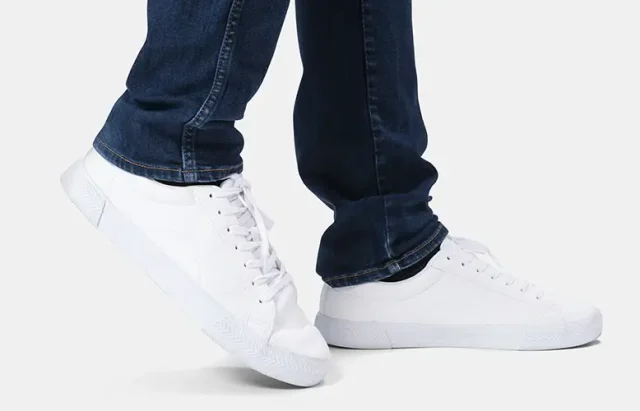
Recently, while traversing a coastal path in southern Portugal, I observed that my feet began to swell by midday. I ensured my sneakers were adequately broken in, selected the appropriate socks, and meticulously verified my size. However, upon arriving at the viewpoint, I found myself contending with two blisters and a persistent discomfort beneath my toes. That evening, accompanied by grilled sardines and a glass of vinho verde, I took to the internet to explore a question that had eluded me for far too long:
Do I need wide shoes?
It appears that a significant number of men engage in this behavior, often without their own awareness.
Footwear is not universally applicable. Nevertheless, countless individuals don footwear that, while ostensibly appropriate in length, fails to accommodate their width requirements adequately. As time progresses, this results in discomfort, exhaustion, diminished efficacy, and potentially enduring harm to the feet.
If you have experienced discomfort along the sides of your feet, numbness in your toes following a walk, or a sensation of pressure that intensifies with each step, this blog is tailored for you. We are analyzing the concept of wide sneakers, identifying the individuals who may benefit from them, and discussing the potential advantages of transitioning to this footwear option for the well-being of your feet this year.
What We’ll Cover in This Blog
This post will explore:
- The difference between standard and wide sneakers
- Common signs your shoes may be too narrow
- Conditions and foot shapes that benefit from wide sneakers
- The benefits of wearing properly fitting wide footwear
- Where to find the best wide sneakers for men that offer style, support, and space
- How modern wide-fit shoes are changing the game for travelers, workers, and athletes alike
Let us begin with a fundamental principle: the width of the foot is equally significant as its length.
Standard vs. Wide Sneakers: What’s the Difference?
The majority of sneaker sizes are determined solely by length, such as size 10, 11, or 12. However, there exists an additional aspect that holds significant importance: breadth.
- Standard Widths: For men, the standard width is usually D.
- Wide Widths: Wide sneakers typically range from 2E to 4E, depending on the brand.
- Extra-Wide or Specialty Widths: You can explore options beyond 4E to address particular medical or orthopedic requirements.
The distinction may appear minimal, an additional 5 to 10 millimeters in the toe box or forefoot, yet it frequently represents the divide between comfort and enduring discomfort.
A wide sneaker transcends mere size. It offers an optimal balance of spaciousness where it matters most: ample room for toe splay, increased depth to accommodate swelling, and reduced sidewall pressure during movement.
Signs You Might Need Wide Sneakers
Many individuals have yet to contemplate the significance of their foot width. Here are several indicators that your present sneakers may be excessively narrow:
- Red marks or blisters along the sides of your foot
- Tingling or numbness in the toes during long walks
- Corns or calluses between toes or on the pinky side
- Bulging at the sides of the shoe
At the conclusion of the day, you may experience a sense of fatigue or constriction in your feet. Consequently, you have begun to steer clear of extended walks, runs, or occupations that require prolonged standing due to discomfort in your feet.
A significant number of these symptoms can be effectively addressed or substantially alleviated through the use of appropriately fitting wide footwear.
Who Actually Needs Wide Sneakers?
The succinct response? A greater number of individuals than one might assume.
Here is an analysis of the primary beneficiaries:
1. Men with Naturally Wide Feet
Some individuals inherently have broader foot structures. This occurrence is notably common among individuals displaying flat feet, high arches, or strong metatarsals. The use of traditional footwear applies pressure to the foot, leading to ongoing discomfort over time.
2. Travelers and Hikers
During extended travel or hiking excursions, it is not uncommon to experience swelling in the feet. A shoe that provides an ideal fit in the morning may become constrictive by the evening. Spacious sneakers facilitate the natural expansion of the foot.
3. Athletes and Active Men
Engaging in activities such as running, jumping, or lifting results in the foot experiencing expansion due to the forces of impact. Wide-fit sneakers enhance stability and mitigate the likelihood of injuries during exercise, training sessions, and competitive athletic endeavors.
4. Men with Foot Conditions
Individuals contending with bunions, hammertoes, diabetes, or plantar fasciitis frequently require footwear that alleviates pressure, accommodates orthotics, and minimizes hotspots. A constricted shoe will only exacerbate these concerns.
5. Men Over 40
With the passage of time, the structure and condition of our feet undergo significant transformations. The arches may descend, the foot may expand marginally, and the cushioning pads may diminish over time. Wide sneakers adapt to these variations and offer enhanced support as required.
6. Workers on Their Feet
For professions that necessitate prolonged periods of standing or walking—such as healthcare providers, educators, manufacturing personnel, and culinary experts—utilizing wide sneakers can alleviate foot fatigue and joint discomfort by distributing pressure more evenly.
The Benefits of Wearing the Right Width
Transitioning to wider sneakers not only enhances comfort. It has the potential to transform the overall sensation and operation of your body.
1. Reduced Pain
Increased space results in reduced nerve compression, diminished inflammation, and minimized friction. Bid farewell to discomfort and embrace seamless progress.
2. Better Blood Flow
Constricted footwear may impede proper blood flow to the extremities. Wide sneakers facilitate the natural functioning of foot muscles and blood vessels, which is essential for individuals with diabetes and the elderly.
3. Improved Balance and Posture
When your foot is firmly anchored and adequately supported, the alignment of your body enhances progressively from the base upwards. This has implications for your knees, hips, and lower back.
4. Greater Endurance
Experience enhanced comfort and improved airflow, allowing you to extend your walking duration, increase your productivity, and elevate your performance — all while remaining oblivious to any discomfort in your feet.
5. More Room for Orthotics
Wide-fit shoes frequently feature removable insoles, rendering them suitable for personalized inserts, arch supports, or orthopedic modifications.
Debunking Myths About Wide Sneakers
“They’re only for old people.”
That is incorrect. The contemporary wide sneakers exemplify a blend of sleek design and modern functionality, catering to athletes, travelers, and individuals from all walks of life.
“They’re bulky and unattractive.”
Companies such as FitVille are at the forefront of creating stylish wide sneakers for men, combining aesthetics with comfort. Discover options that are appropriate for the gym, the workplace, or your upcoming urban exploration.
“Just go up a size.”
Opting for a longer shoe to address width issues is an error in judgment. It disrupts your stride, undermines your arch stability, and leads to heel displacement. It is essential to ensure that both dimensions, length and width, are in alignment.
FitVille: Wide Sneakers That Actually Work





